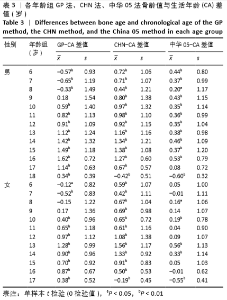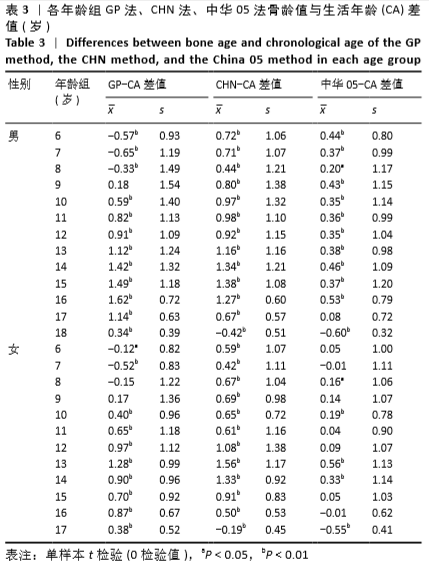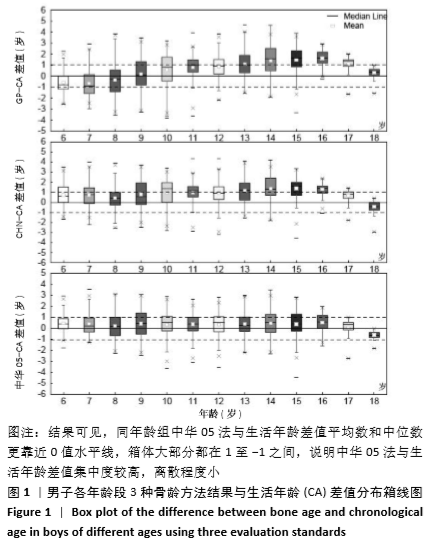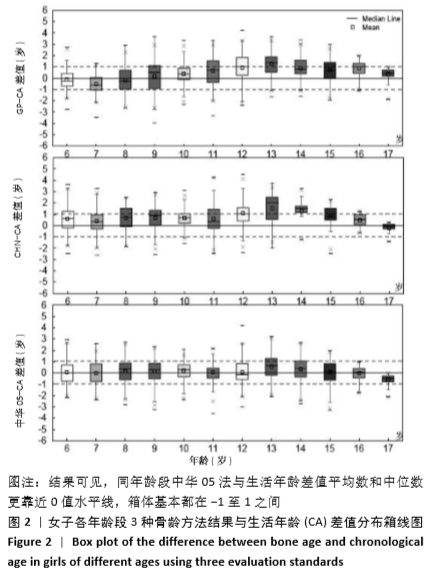[1] 王亚辉,朱广友,乔可,等.X线骨龄评估方法研究进展与展望[J].法医学杂志,2007,23(5):365-369.
[2] 张绍岩,王姿欢,蒋竞雄.骨龄评价方法的发展及应用[J].中国妇幼卫生杂志,2012,3(6):345-348.
[3] 叶义言.中国儿童骨龄评分法[M].北京:人民卫生出版社,2004: 51-62.
[4] TANNER JM, WHITEHOUSE RH, CAMERON N, et al. Assessment of skeletal maturity and prediction of adult height (TW2 method). 2nd ed.London: Academic Press.1983:22-37.
[5] GREULICH WW, PYLE SI. Radiographic atlas of skeletal development of the hand and wrist. California: Stanford University Press.1959:1-205.
[6] 张绍岩,邵伟东,杨世增,等.中国人骨成熟度评价标准及应用-CHN计分法和骨龄标准图谱[M].北京:人民体育出版社,1995:24-53.
[7] 张绍岩,马振国,沈勋章,等.中国人手腕骨发育标准——中华05.IV.中国儿童手腕骨发育特征[J].中国运动医学杂志, 2007,26(4): 452-455.
[8] 张鹏飞,李辉.三种骨龄评价方法在3~17岁儿童临床应用中的一致性比较研究[J].中国循证儿科杂志, 2017,12(4):263-267.
[9] 张绍岩.中国人手腕骨部骨龄标准—中华05及其应用[M].北京:科学出版社,2015:94-95.
[10] DUREN DL, NAHHAS RW, SHERWOOD RJ. Do Secular Trends in Skeletal Maturity Occur Equally in Both Sexes?.Clin Orthop Relat Res.2015; 473(8):2559-2567.
[11] SURI S, PRASAD C, TOMPSON B, et al. Longitudinal comparison of skeletal age determined by the Greulich and Pyle method and chronologic age in normally growing children, and clinical interpretations for orthodontics.Am J Orthod Dentofacial Orthop.2013;143(1):50-60.
[12] Rezwana BM, Dola SR, Alampur SG, et al. Is Greulich and Pyle standards of skeletal maturation applicable for age estimation in South Indian Andhra children?.J Pharm Bioallied Sci.2015;7(3):218-255.
[13] 张绍岩,花纪青,刘丽娟,等.中国人手腕骨发育标准—中华05.III.中国儿童骨发育的长期趋势[J].中国运动医学杂志, 2007, 26(2):149-153.
[14] 季成叶,胡佩瑾,何忠虎.中国儿童青少年生长长期趋势及其公共卫生意义[J].北京大学学报(医学版),2007,39(2):126-131.
[15] Zong XN, Li H. Construction of a New Growth References for China Based on Urban Chinese Children: Comparison with the WHO Growth Standards. PLoS ONE.2013;8(3):e59569.
[16] 张绍岩, 吴真列, 沈勋章,等.中国人手腕骨发育标准—中华05Ⅱ.RUS-CHN和TW_3-C腕骨方法的读片可靠性[J]. 中国运动医学杂志,2006,25(6):641-646.
[17] PAXTON ML, LAMONT AC, STILLWELL AP. The reliability of the Greulich–Pyle method in bone age determination among Australian children.J Med Imaging Radiat Oncol.2013;57(1):21-24.
[18] ACHESON RM, VICINUS JH, FOWLER GB. Studies in the reliability of assessing skeletal maturity from x-rays. 3. Greulich-Pyle Atlas and Tanner-Whitehouse method contrasted.Human biology.1966;38(3): 204.
[19] BULL RK, EDWARDS PD, KEMP PM, et al. Bone age assessment: a large scale comparison of the Greulich and Pyle, and Tanner and Whitehouse (TW2) methods.Arch Dis Child.1999;81(2):172-173.
[20] 张绍岩,刘丽娟,吴真列,等.中国人手腕骨发育标准—中华05 I.TW3-CRUS、TW3-C腕骨和RUS-CHN方法[J].中国运动医学杂志, 2006,29(5):6-13.
[21] 姚乐辉.儿童青少年骨龄测评方法比较研究[D].北京:北京体育大学,2015.
[22] 高雪峰,徐勇灵.CHN与CHN05两种骨龄评价标准在法医学骨龄推测中的对比研究[J].甘肃医药,2011,30(8): 456-458.
[23] 张绍岩,刘丽娟,花纪青等.青少年手腕骨骨龄与生活年龄的差异观察[J].中国法医学杂志,2009,24(1):18-20.
[24] 熊丰, 谢吉,陈凤生,等.三种常用骨龄评价方法的比较[J].临床儿科杂志,2000,18(5):273-274.
[25] 张绍岩,刘丽娟,刘刚,等.中国人手腕骨发育标准-中华05V.骨成熟度百分位数曲线的修订[J].中国运动医学杂志, 2009,28(1): 20-24.
[26] ZHANG A, SAYRE JW, VACHON L, et al. Racial Differences in Growth Patterns of Children Assessed on the Basis of Bone Age.Radiology. 2009;250(1):228-235.
[27] HOCHBERG Z. Diagnosis of endocrine Disease: On the need for national-, racial-, or ethnic-specific standards for the assessment of bone maturation.Eur J Endocrinol.2016;174(2):R65-70.
[28] 中国学生体质与健康研究组.2010年中国学生体质与健康调研报告[M].北京:高等教育出版社,2010:75-77.
[29] KIM JR, LEE YS, YU J. Assessment of bone age in prepubertal healthy Korean children: comparison among the Korean standard bone age chart, Greulich-Pyle method, and Tanner-Whitehouse method.Korean J Radiol.2015;16(1):201-205. |





